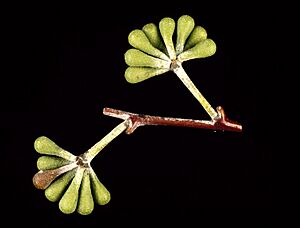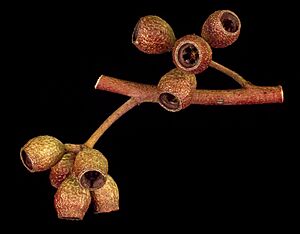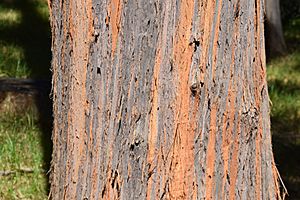Alpine ash facts for kids
Quick facts for kids Alpine ash |
|
|---|---|
 |
|
| Eucalyptus delegatensis growing between Corryong and Omeo | |
| Scientific classification | |
| Genus: |
Eucalyptus
|
| Species: |
delegatensis
|
Eucalyptus delegatensis, commonly known as alpine ash, gum-topped stringybark, or white-top, is a type of tree found only in southeastern Australia. In Victoria, it is also called woollybutt. This tree has a straight trunk. The bark on the lower half of the trunk is rough and stringy. The upper part has smooth, white bark. Its adult leaves are long and curved. The flowers are white and grow in groups of seven to fifteen. The fruit looks like a barrel or half-sphere.
Contents
What Alpine Ash Looks Like
Alpine ash trees usually grow to be about 40–50 m (130–160 ft) (130-160 feet) tall. Some can even reach 90 m (300 ft) (295 feet)! This tree can also form a lignotuber, which is a woody swelling at the base. It helps the tree regrow after a fire.
Bark and Leaves
The bark on the lower part of the trunk is rough. It can be grey to black and feels fibrous or stringy. Higher up, the bark is smooth and white or greyish.
Young plants and new shoots have broad, lance-shaped leaves. These leaves are about 70–200 mm (2.8–7.9 in) (2.8-7.9 inches) long and 27–82 mm (1.1–3.2 in) (1.1-3.2 inches) wide. Adult leaves are glossy green or bluish-green on both sides. They are lance-shaped to curved, about 75–230 mm (3.0–9.1 in) (3-9 inches) long and 13–55 mm (0.51–2.17 in) (0.5-2.2 inches) wide. These leaves grow on a stalk called a petiole, which is 10–45 mm (0.39–1.77 in) (0.4-1.8 inches) long.
Flowers and Fruit
The flower buds grow in groups of seven to fifteen. They are found in the leaf axils (where the leaf meets the stem). Each group of buds grows on a stalk called a peduncle, which is 8–20 mm (0.31–0.79 in) (0.3-0.8 inches) long. Each individual bud has a smaller stalk called a pedicel, about 3–5 mm (0.12–0.20 in) (0.1-0.2 inches) long.
Mature buds are oval or club-shaped. They can be green, yellow, or red. They are about 4–5 mm (0.16–0.20 in) (0.16-0.2 inches) long and wide. Each bud has a cap called an operculum that is conical or rounded with a small point.
Alpine ash trees bloom between December and March. Their flowers are white. The fruit is a woody capsule. It is shaped like a barrel or half-sphere and is about 6–11 mm (0.24–0.43 in) (0.24-0.43 inches) long and wide. The parts that open to release seeds are usually near the rim or inside the fruit.
How Alpine Ash Got Its Name
The Eucalyptus delegatensis was first officially described in the year 1900. It was described by a scientist named Richard Thomas Baker. He used a sample collected by William Baeuerlen from "Delegate Mountain." The description was published in a scientific journal called Proceedings of the Linnean Society of New South Wales. The name delegatensis comes from the place where the first sample was found, which is called the type location.
Different Types of Alpine Ash
In 1985, another scientist, Douglas John Boland, identified two different types, or subspecies, of Alpine ash. These names are now officially accepted:
- Eucalyptus delegatensis R.T.Baker subsp. delegatensis: This type has broadly lance-shaped young leaves. It is found in New South Wales and Victoria.
- Eucalyptus delegatensis subsp. tasmaniensis Boland: This type has more rounded young leaves with a short "drip-tip." It grows only in Tasmania.
Where Alpine Ash Grows
Alpine ash is very common in certain areas. It often grows in large groups in grassy or wet subalpine forests. These trees prefer deep, fertile soil, often on slopes. They commonly form pure stands, meaning they grow together without many other tree species mixed in.
In New South Wales and the Australian Capital Territory, you can find Alpine ash south of the Brindabella Range. In Victoria, it grows at high altitudes, between 900 and 1,500 m (3,000 and 4,900 ft) (2,950 and 4,920 feet), east of Mount Macedon. The subspecies tasmaniensis is found only in Tasmania.
See also
 In Spanish: Fresno Alpino para niños
In Spanish: Fresno Alpino para niños




